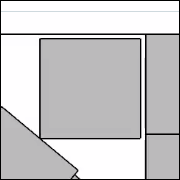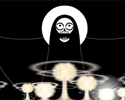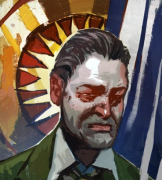|
I just barely finished LO: TXWG and now I have a notice Howl of the Wild is on the way!
|
|
|
|

|
| # ? May 5, 2024 03:45 |
|
Scoss posted:I recently had my players fight an Ochre Jelly, which notably has the ability to split and double itself any time it takes certain types of damage. To my incredible joy, the fight started with one player stabbing it with a rapier to cause it to split, followed by another using electric arc to produce 4 Oozes. They scrambled like panicked cats to evacuate the room that was now full of oozes and started hurling beads from the necklace of fireballs they just found through the doorway. Even though it was a Low difficulty encounter I think it turned out pretty memorable because of its completely unexpected ability that quickly turned the situation upside-down. I liked running an encounter with a lurker in light. They reverse the light/dark dynamic of visibility by hiding in bright light. You can do environmental effects with destroying lighting to limit its movement because it has dimension door but only between areas of bright light. The lurkers can cause a character to emit bright light in the backline and jump between them with dimension door. https://2e.aonprd.com/Monsters.aspx?ID=726
|
|
|
|
Autodrop Monteur posted:Nexus, I don't know, it feels like it's made for people who use Beyond and just want a pretty interface or something. I've found the website to be terribly slow. On top of that, Archive of Nethys + Pathbuilder are so much faster and easier to use as both a player and a GM. DnDBeyond was actually pretty ok to DM from because it has reasonably fast servers and good hyperlinking, the problem was that it was 5e content but that's not the website's fault.
|
|
|
|
Wall of fire. quote:You raise a blazing wall that burns creatures passing through it. You create either a 5-foot-thick wall of flame in a straight line up to 60 feet long and 10 feet high, or a 5-foot-thick, 10-foot-radius ring of flame with the same height. The wall stands vertically in either form; if you wish, the wall can be of a shorter length or height. Everything on each side of the wall is concealed from creatures on the opposite side. Any creature that crosses the wall or is occupying the wall's area at the start of its turn takes 4d6 fire damage. How do you calculate a 5 foot thick ring of flame? Is the 10 foot radius the inner edge of the wall, or the outer edge of the wall? If it's the outer edge it seems like it could completely fill the interior of the 10 foot radius diagram. The entire grey area would be full of fire leaving nowhere to stand. Or maybe it would look like one of these?   If it's the inner edge the wall could end up like this?  Or maybe like this? 
|
|
|
|
I'd say either of these would be acceptable (maybe leaning toward the latter based on how the "circular" area effect templates work), using the other part of the spell effect as a power comparison:quote:in a straight line up to 60 feet long Both of those images consist of 12 five-foot squares of fire, whereas the others don't.
|
|
|
|
I'm looking for a little help from people (particularly GMs) experienced in Pathfinder 2.0. I'm in the midst of cobbling together a Frankenstein's monster of a fantasy system that does all the things I want as a GM. It's not for publishing, just my own table, and my players are up for it. I'm bringing in elements from a variety of systems I've run over the years, but reading through the Pathfinder rules I see some things I'd like to incorporate as well. Having never run Pathfinder though, I'm less sure about the implications of using a couple of them. Some things I already know I'm stealing, like PF's robust weapon traits and tag systems, and those should meld without much trouble. There are two more major elements I like, but I'm a little gun-shy about building around them without more insight: 1. The three action turn (and increased spell-casting actions) 2. No Default AoO I'm wary about any downstream/knock-on effects these have that wouldn't be immediately apparent, (and which might therefore make a big balance issue when mixed with other rules). For instance, does the three-action turn end up giving a big boost to ranged martial characters, since they're not spending actions on catching/changing targets? Can particularly mobile characters turn melee encounters into a Benny Hill race when AoOs aren't in play? Are these options only kept viable by some other supporting rules I might be overlooking? I know it's a little vague, but I'd appreciate any emergent effects people can point out stemming from those two rules (especially 3-action turn, since I'd be hanging the whole combat system around that). I'll still be play-testing this monster, but I'd like to start from the most informed place possible. Thanks!
|
|
|
|
The three action system works to balance ranged character by having consecutive attacks at increased penalties. Second attacks are at -5 and the third is at -10. There are feats and weapons that can reduce that penalty but they are pretty rare for ranged characters. I can only think of one or two off the top of my head. Casters are typically only firing off a single spell each turn. Or a spell and minor cantrip at best. You'd have to balance every action/activity around the 3 action system. It rolls into everything else in the game. It even has social and exploration impacts. It's pretty expensive.
|
|
|
|
3 Action system works so well I'll be shocked if D&D 6e doesn't end up having it as at least an optional variant
|
|
|
|
I've never in any campaign seen melee (or any players) decide to just kite monsters due to AoO not being a default feature. After all, if you run away then you can't hit THEM!
|
|
|
|
Gwaihir posted:I've never in any campaign seen melee (or any players) decide to just kite monsters due to AoO not being a default feature. The absolute extent of this I've seen done is people with reach weapons taking a Step back so they're two squares away and then attacking, because it means the enemy has to spend one of their actions walking up to you, and that seems about the limit of how useful any sort of kiting can be outside of extremely rare gimmicks. 
|
|
|
|
Gwaihir posted:I've never in any campaign seen melee (or any players) decide to just kite monsters due to AoO not being a default feature. I think kiting strategies come into play against some very slow enemies, like oozes.
|
|
|
|
Depends on the map, how the GM uses enemy abilities, and how open players are to run the game more like a Jackie Chan movie than Fire Emblem
|
|
|
|
Silver2195 posted:I think kiting strategies come into play against some very slow enemies, like oozes. The kobold one shot adventure has an enemy with a speed 10 (maybe 15?) that can't be beaten in a straight-up fight but is trivial if you use hit and run tactics. Of course, our rogue tried to face tank it and was immediately knocked out.
|
|
|
|
Thank you for all the responses so far! Hit and run tactics aren't really a discouraging problem, especially since monsters can use them too. That's a facet I'm probably overthinking, since 5e monsters have so many HP that it's basically already fine for them to tank AoO attacks unless someone has sentinel. Ravus Ursus posted:The three action system works to balance ranged character by having consecutive attacks at increased penalties. Second attacks are at -5 and the third is at -10. There are feats and weapons that can reduce that penalty but they are pretty rare for ranged characters. I can only think of one or two off the top of my head. Ravus Ursus posted:You'd have to balance every action/activity around the 3 action system. It rolls into everything else in the game. It even has social and exploration impacts. It's pretty expensive. Would you mind elaborating on this a little bit? I'm fine with the workload of setting/borrowing an action cost for most things, but I suspect you're talking about things like 'how powerful can attacks be when you can make three a turn; how many bonuses are available to trivialize the multi-attack penalty; how many HP do things need to have to survive a round etc. I maybe don't see a huge difference between power levels with 5E's action/move/bonus system, but since I haven't run Pathfinder maybe I'm being naive. As far as social and exploration, I'm not really looking at importing any of PF's out-of-combat rules, but I'm curious what you mean by the impact there. mind the walrus posted:3 Action system works so well I'll be shocked if D&D 6e doesn't end up having it as at least an optional variant Yeah it seems like a more elegant/flexible alternative to 5E's action economy that helps bring martials in line with casters, but maybe I'm underestimating the downstream issues?
|
|
|
|
Leatherhead posted:Yeah it seems like a more elegant/flexible alternative to 5E's action economy that helps bring martials in line with casters, but maybe I'm underestimating the downstream issues?
|
|
|
|
The other Pathfinder 2e system you should steal is the 4 degrees of success. The gist is that if you beat a DC by 10 or more you get a crit success, failing by 10 or more is a crit fail, and natural 20/1 improves/worsens your degree of success by 1. A bunch of spells and abilities then have four different degrees of effect. This means that they can still do something on a player failure / enemy success, making the action not feel like a total waste, and you can have really nasty effects on a player crit success / enemy crit failure without breaking things. Also, it makes every +1 twice as impactful, because it usually changes the result of two different die rolls (e.g. if you would succeed on a 9 and crit on a 19, you now succeed on 8 and crit on 18).
|
|
|
|
|
To me an important thing about the 3-action system is to have multiple good third action for every character if you're going to penalize multiple attacks. Pathfinder does it pretty well with melee and stealth characters, but I still think its lacking for casters. If I were making a homebrew system with 3-actions I would make all leveled spells take 2 or more actions, and cantrips are 1 action that scale like weapons or are slightly weaker. Edit: Non-default AoO hasn't been much of an issue because everything CAN have an AoO. It's still a threat in every new fight and you don't have to AoO everyone. If a wizard and a champion are both moving, you can skip the champion and attack the wizard.
|
|
|
|
The main consequence of the 3-action economy and non-default AoO for me are that it makes combat far more dynamic WITHOUT becoming a Benny Hill clown fiesta of kiting. Because movement has an actual cost, it encourages small tactical plays that leave foes just out of range of where they want to be, or otherwise causes them to waste actions on repositioning rather than going nuts with attacks. The MAP penalty further encourages characters to think about if there's a bigger tactical move they can make rather than just swing again.
|
|
|
|
Leatherhead posted:Would you mind elaborating on this a little bit? I'm fine with the workload of setting/borrowing an action cost for most things, but I suspect you're talking about things like 'how powerful can attacks be when you can make three a turn; how many bonuses are available to trivialize the multi-attack penalty; how many HP do things need to have to survive a round etc. I maybe don't see a huge difference between power levels with 5E's action/move/bonus system, but since I haven't run Pathfinder maybe I'm being naive. As far as social and exploration, I'm not really looking at importing any of PF's out-of-combat rules, but I'm curious what you mean by the impact there? A lot of the action system ties to the way the system handles growth as well. While 5e gives martials additional attacks they level, PF2 does not. A fighter and a wizard both using a mace are both swinging for 1d6+str. They both add their str and proficiency to hit. For a wizard thats a +3 as they're trained in simple weapons. For the warrior it's +9. The gap will grow as PF2 adds your level to your proficiency as well as the 4 tiers of expertise. Extra dice damage comes from the runes and weapon customization system. The other thing is that casters don't really gain bonuses to hit on their spells like martials do with the weapons. I think there may be 1 item in the game that gives a caster an increased chance to hit with spell attacks. The action system did a lot to bring martials up to par as they can feasibly, at high levels, swing 3 or 4 times for 4d8+5 and the wizards got one spell slot to blow a Massacre for 9d6, 100 damage, instant kill, or nothing depending on the savjng throw. The removal of bounded accuracy means that low level enemies will stop posing a threat at some point, where even a critical hit still can't hit the players. The same is true for monsters. Even a monster 2 levels higher can seriously tear a party apart. Especially at lower levels. AOO being nonstandard also means that actions like trip and shove are significantly more powerful. A success trip means the enemy has to spend a movement standing, picking up it's weapons,.and then either.moving or attacking. There are entire successful strategies that consist of a fighter just bullying an enemy and never actually hitting it while the rest of the team either pour on damage or handles other threats. I always find myself turning to this one stat block to really emphasize how powerful and dynamic PF2 can be. https://2e.aonprd.com/Monsters.aspx?ID=113 The key point is this bit: Archives of Nethys posted:Tactician of Cocytus [one-action] (concentrate) An ice devil’s logical mind devises genius tactics from its perfect memory. It can telepathically send a tactical repositioning to its allies, allowing all commanded or allied evil creatures in the range of its telepathy to immediately Stride (or Burrow, Climb, Fly, or Swim, if the creature has the corresponding Speed). For one action, this devil can have every ally within 100ft take a move action, immediately. This doesn't even take into account that it has frightful presence, a number of spells to wall off areas, slow the party, teleport, and all of its melee attacks can inflict slow. There is a tremendous amount of power in that one action than at first glance when you consider the spill over. If any player is slowed they're struggling for actions already. Any strategy with positioning is undone when every enemies gets a free movement..any range character that were comfortably out of range may suddenly be in dire straights. There's a lot that the action system impacts beyond just the numbers. Honestly the best way to get a good feel for it is to run the same scenario in both DND and PF and look at the difference in options with regards to stat blocks. I had a 3 person party at level 1 almost get completely wiped by a single level 2 boar. Almost every enemy has something they can do that costs multiple actions that can make a meaningful impact of in a fight. Most enemies in DND that have anything beyond an attack have legendary actions and a lot of those actions are just doing more attacks than they would otherwise be able to do. The system, for the faults it does have, is pretty tightly designed in how numbers, options, and strategy all play into one another.
|
|
|
|
gurragadon posted:To me an important thing about the 3-action system is to have multiple good third action for every character if you're going to penalize multiple attacks. Pathfinder does it pretty well with melee and stealth characters, but I still think its lacking for casters. If I were making a homebrew system with 3-actions I would make all leveled spells take 2 or more actions, and cantrips are 1 action that scale like weapons or are slightly weaker. The casters I've run mostly solve this by being the ones to really swing a battle one direction or another with proper spell placement, but they struggle immensely when a fight requires them to run/hide/position for proper line of sight and damage because "I don't want to 'waste' my turn." They tend to default to Recall Knowledge for this a lot too, well after they've maxed out what they could learn from it. At risk of dragging this back up, I do think this is where a modification to so many spell/abilities saves that the monsters have to perform might go a bit better. Or maybe make attack spells 1 action, but overall weaker, and buff/debuff/area control spells both more powerful and 2 actions, and you'll see more of a split between people who want to be battle casters and those who want to control the field. Or just play Kineticist 
|
|
|
|
Give relevant non-control-y spells the flourish trait and cut them to 1 action or add feats to let you move and cast or recall knowledge and cast or…, since spellcasters have no action compression or mitigation besides a free sustain feat at level 14 or prebuffing with haste Or even just do many more modular action spells, cantrips included There’s lots of hypothetical solutions but casters effectively getting 2 things to do each turn instead of 3 is a waste
|
|
|
|
Outside of the very early levels (like... 1-3), casters are fine if the caster in question is picking a diverse array of defenses to target and is picking things that have a good effect even on a succeeded save. Now, granted, that opinion is formed with the understanding that GMs are using a blend of encounter threat levels and getting over megalixir syndrome and hoarding everything. Some players never get over that, and I think those players and the "well my caster broke everything in 5e why can't I here???" ones coming from 5e are the ones that cause the largest "well casters suck" noise.
|
|
|
|
Thank you all for the detailed responses (especially from Ravus Ursus). There's a lot to love in PF's combat and I think I might enjoy running a few short games just to feel out where I'd run into trouble grafting it onto other systems. The idea of setting up the 'same' encounter in 5E and PF is a great one. I might pop up in a month or two with some more focused balance questions, but for now I've got a lot to chew on!
|
|
|
|
Kyrosiris posted:Outside of the very early levels (like... 1-3), casters are fine if the caster in question is picking a diverse array of defenses to target and is picking things that have a good effect even on a succeeded save. Now, granted, that opinion is formed with the understanding that GMs are using a blend of encounter threat levels and getting over megalixir syndrome and hoarding everything. Personally? I blame the gently caress out of video games. Like it is absolutely video game's fault here. They train players and GMs alike to see environments as very static, non-interactive elements that their abilities/powers won't affect at all unless there's a fuckton of visual representation like "oh there's a carpet here I can pull." The battlefield is nothing but participants and some incidental geometry, and the rest is figuring out how one can hit the other until someone's HP bar runs out. They're very afraid to invent things in this regard, and GMs don't roll with it as well -- "am I standing on a carpet?" is a quick and dirty example. A lot of players will not think to invent a carpet in their minds unless the battlemap or VTT very specifically shows one, and the GM may panic out of fear of breaking encounter balance and say "no," and that also limits potential options to "solve" combat. As a GM I really really try to give hints about potential, but I can only do so much before I'm doing the analog version of "there's a glowing red weak spot on this part of the environment, press x to trigger it." Players have to be willing to take chances, and GMs have to be willing to go along with it. quote:Some players never get over that, and I think those players and the "well my caster broke everything in 5e why can't I here???" ones coming from 5e are the ones that cause the largest "well casters suck" noise. Leatherhead posted:I might pop up in a month or two with some more focused balance questions, but for now I've got a lot to chew on! mind the walrus fucked around with this message at 22:10 on May 4, 2024 |
|
|
|
gurragadon posted:To me an important thing about the 3-action system is to have multiple good third action for every character if you're going to penalize multiple attacks. Pathfinder does it pretty well with melee and stealth characters, but I still think its lacking for casters. If I were making a homebrew system with 3-actions I would make all leveled spells take 2 or more actions, and cantrips are 1 action that scale like weapons or are slightly weaker. 1 action cantrips would be a lot of rolls. To keep things moving it might be better to have some cantrips that work like Magic Missle where you choose to spend 1-3 actions and the spell changes based on how many actions you use, but only requires a single attack roll or saving throw. Though 3 separate rolls would mean they usually hit at least once. OTOH I really like that casters have a dangling third action. It gives them a reason to use combat skill actions, and I love skill actions. Charisma casters can use Demoralize or Bon Mot which are both arguably as powerful as a cantrip. Wisdom and Intelligence casters are great at some of the Recall Knowledge actions, which can be very strong (if you can convince people to use them). Knowing best/worst save, weaknesses, or resistances, can effectively give the casters a bonus on subsequent turns as they choose the most effective spells. Use your big brain, big brain caster guy.
|
|
|
|
A lot of those are also very good first actions that you should use to set up for your spell to have better odds. 
|
|
|
|
IMO, the other big thing to keep in mind about the 3-action system is that it bakes in some non-obivous asymmetry just from how the classes are structured. Casters are generally doing "spell plus one action", most martials are mixing and matching, monks play differently right off the bat because flurry means they effectively have four actions instead of three when they most need it, etc. mind the walrus posted:To this end I do think a lot of martials in PF2e start to realize the diversity of options they can use in combat but still freeze up at thinking of environmental usage -- cutting a rope to cause items to fall down, knocking over a cabinet to create a wall/path, etc. Spellcasters really can do the same with their cantrips or basic attack spells, but have more trouble seeing a battlefield in this way. As starting point, put stuff on the map. I'm a big fan of having ladders, fireplaces, chandeliers, etc on a battlemap as prelabeled hazards with trigger conditions that both the PCs and enemies are aware of. This gives some complications to positioning and actions right off without any 'bullshit!' factor from having unexpected mechanical things sprung on the players.
|
|
|
|
Leatherhead posted:Thank you all for the detailed responses (especially from Ravus Ursus). There's a lot to love in PF's combat and I think I might enjoy running a few short games just to feel out where I'd run into trouble grafting it onto other systems. The idea of setting up the 'same' encounter in 5E and PF is a great one. If you run a few encounters side by side, be absolutely sure to have a list of every action you can take for the PF2 character. Pathbuilder will let you print out a sheet with each action the character has on it. I emphasize this because skipping to a level 5 combat encounter with 4 characters in a system you've never run is going to be A LOT of data. And people will default to taking turns in the system they're most familiar with. There are a lot of default actions anyone can take but class and skill actions can add to that list quickly.
|
|
|
|
Roadie posted:IMO, the other big thing to keep in mind about the 3-action system is that it bakes in some non-obivous asymmetry just from how the classes are structured. My AV group recently hit the floor just past the Ghostwall and let me tell you, it's been great what with all the holes and pitfalls to the lower area. My halberd fighter, wood kineticist, and our swashbuckler have been playing minigolf basically. Huge fan of environmental hazards that do more than just 'well, it's difficult terrain'
|
|
|
|
Thinking about getting into this, have a few questions. I have the Player core book, and was thinking of getting the Outlaws of Alkenstar path to run friends through. What all else should I buy? What's the best generic monster manual they have right now? What 2e book has the gunslinger in there for cowboy maximizing?
|
|
|
|

|
| # ? May 5, 2024 03:45 |
|
theironjef posted:Thinking about getting into this, have a few questions. I have the Player core book, and was thinking of getting the Outlaws of Alkenstar path to run friends through. What all else should I buy? What's the best generic monster manual they have right now? What 2e book has the gunslinger in there for cowboy maximizing? The new monster book is "Monster Core" but if you're running an adventure path you don't need it. If there is a unique monster it should be in the AP book itself. Generic monster stat blocks can easily be looked up on the free and totally legal sites Archives of Nethys https://2e.aonprd.com/ or Demiplane https://app.demiplane.com/nexus/pathfinder2e The book for Gunslingers and Inventors is Guns and Gears. e: If you've never played 2e before and your budget isn't too tight I highly recommend the Pathfinder Beginner Box. It acts as a tutorial level for both the players and the GM. It starts with a classic rats in a basement fight, then gradually adds new rules with each challenge to ease you into things. For simplicity I'd consider using the included pregen characters so you get a handle on the base rules before adding weird stuff.  To make sure you get the right one check the tag in the upper right corner. It should say "Second Edition" or "Second Edition Remaster" Facebook Aunt fucked around with this message at 00:36 on May 5, 2024 |
|
|


























